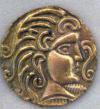WiFi Signals Harvested to Power Small Electronics

With the rise of the digital age, the amount of WiFi sources to transmit information wirelessly between devices has grown exponentially. This results in the widespread use of the 2.4GHz radio frequency that WiFi uses, with excess signals available to be tapped for alternative uses.
To harness this under-utilised source of energy, a research team from the National University of Singapore (NUS) and Japan’s Tohoku University (TU) has developed a technology that uses tiny smart devices known as spin-torque oscillators (STOs) to harvest and convert wireless radio frequencies into energy to power small electronics. In their study, the researchers had successfully harvested energy using WiFi-band signals to power a light-emitting diode (LED) wirelessly, and without using any battery.
The research breakthrough was achieved by a team led by Professor Yang Hyunsoo (left). Dr Raghav Sharma (right), the first author of the paper, is holding a chip embedded with about 50 spin-torque oscillators.
The research was carried out in collaboration with the research team of Professor Guo Yong Xin, who is also from the NUS Department of Electrical and Computer Engineering, as well as Professor Shunsuke Fukami and his team from TU. The results were published in Nature Communications on 18 May 2021.
Converting WiFi signals into usable energy
Spin-torque oscillators are a class of emerging devices that generate microwaves, and have applications in wireless communication systems. However, the application of STOs is hindered due to a low output power and broad linewidth.
While mutual synchronisation of multiple STOs is a way to overcome this problem, current schemes, such as short-range magnetic coupling between multiple STOs, have spatial restrictions. On the other hand, long-range electrical synchronisation using vortex oscillators is limited in frequency responses of only a few hundred MHz. It also requires dedicated current sources for the individual STOs, which can complicate the overall on-chip implementation.
To overcome the spatial and low frequency limitations, the research team came up with an array in which eight STOs are connected in series. Using this array, the 2.4 GHz electromagnetic radio waves that WiFi uses was converted into a direct voltage signal, which was then transmitted to a capacitor to light up a 1.6-volt LED. When the capacitor was charged for five seconds, it was able to light up the same LED for one minute after the wireless power was switched off.
In their study, the researchers also highlighted the importance of electrical topology for designing on-chip STO systems, and compared the series design with the parallel one. They found that the parallel configuration is more useful for wireless transmission due to better time-domain stability, spectral noise behaviour, and control over impedance mismatch. On the other hand, series connections have an advantage for energy harvesting due to the additive effect of the diode-voltage from STOs.
Commenting on the significance of their results, Dr Raghav Sharma, the first author of the paper, shared, “Aside from coming up with an STO array for wireless transmission and energy harvesting, our work also demonstrated control over the synchronising state of coupled STOs using injection locking from an external radio-frequency source. These results are important for prospective applications of synchronised STOs, such as fast-speed neuromorphic computing.”
Next steps
To enhance the energy harvesting ability of their technology, the researchers are looking to increase the number of STOs in the array they had designed. In addition, they are planning to test their energy harvesters for wirelessly charging other useful electronic devices and sensors.
The research team also hopes to work with industry partners to explore the development of on-chip STOs for self-sustained smart systems, which can open up possibilities for wireless charging and wireless signal detection systems.
Contacts and sources:
National University of Singapore (NUS)
Publication
Source: http://www.ineffableisland.com/2021/05/wifi-signals-harvested-to-power-small.html
Anyone can join.
Anyone can contribute.
Anyone can become informed about their world.
"United We Stand" Click Here To Create Your Personal Citizen Journalist Account Today, Be Sure To Invite Your Friends.
Before It’s News® is a community of individuals who report on what’s going on around them, from all around the world. Anyone can join. Anyone can contribute. Anyone can become informed about their world. "United We Stand" Click Here To Create Your Personal Citizen Journalist Account Today, Be Sure To Invite Your Friends.
LION'S MANE PRODUCT
Try Our Lion’s Mane WHOLE MIND Nootropic Blend 60 Capsules
Mushrooms are having a moment. One fabulous fungus in particular, lion’s mane, may help improve memory, depression and anxiety symptoms. They are also an excellent source of nutrients that show promise as a therapy for dementia, and other neurodegenerative diseases. If you’re living with anxiety or depression, you may be curious about all the therapy options out there — including the natural ones.Our Lion’s Mane WHOLE MIND Nootropic Blend has been formulated to utilize the potency of Lion’s mane but also include the benefits of four other Highly Beneficial Mushrooms. Synergistically, they work together to Build your health through improving cognitive function and immunity regardless of your age. Our Nootropic not only improves your Cognitive Function and Activates your Immune System, but it benefits growth of Essential Gut Flora, further enhancing your Vitality.
Our Formula includes: Lion’s Mane Mushrooms which Increase Brain Power through nerve growth, lessen anxiety, reduce depression, and improve concentration. Its an excellent adaptogen, promotes sleep and improves immunity. Shiitake Mushrooms which Fight cancer cells and infectious disease, boost the immune system, promotes brain function, and serves as a source of B vitamins. Maitake Mushrooms which regulate blood sugar levels of diabetics, reduce hypertension and boosts the immune system. Reishi Mushrooms which Fight inflammation, liver disease, fatigue, tumor growth and cancer. They Improve skin disorders and soothes digestive problems, stomach ulcers and leaky gut syndrome. Chaga Mushrooms which have anti-aging effects, boost immune function, improve stamina and athletic performance, even act as a natural aphrodisiac, fighting diabetes and improving liver function. Try Our Lion’s Mane WHOLE MIND Nootropic Blend 60 Capsules Today. Be 100% Satisfied or Receive a Full Money Back Guarantee. Order Yours Today by Following This Link.






